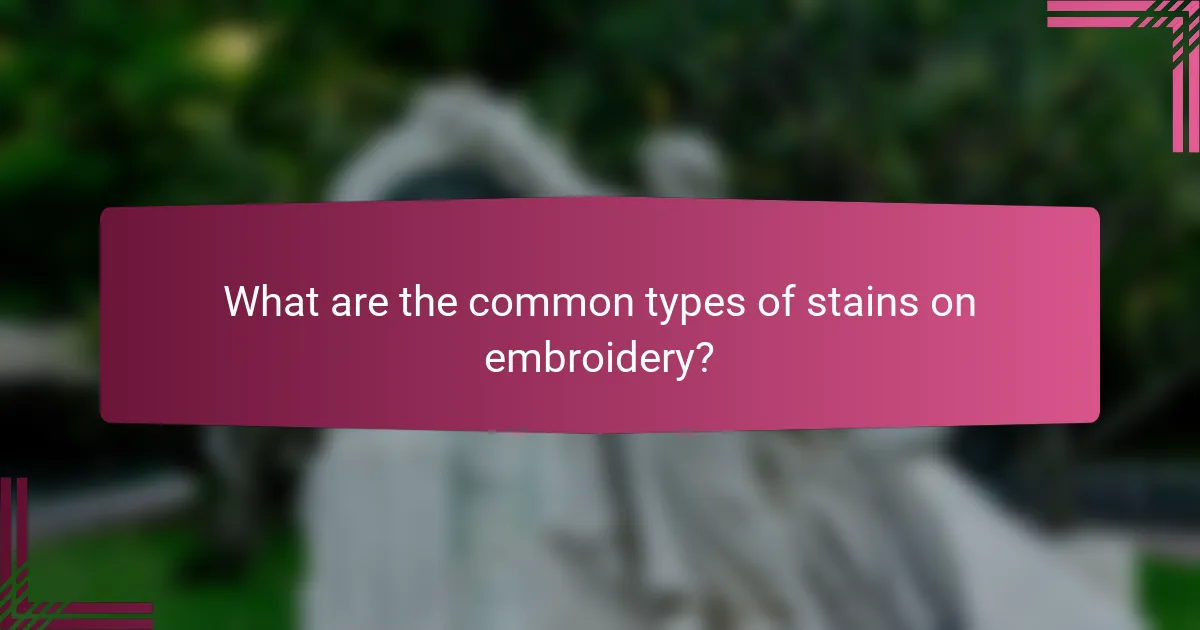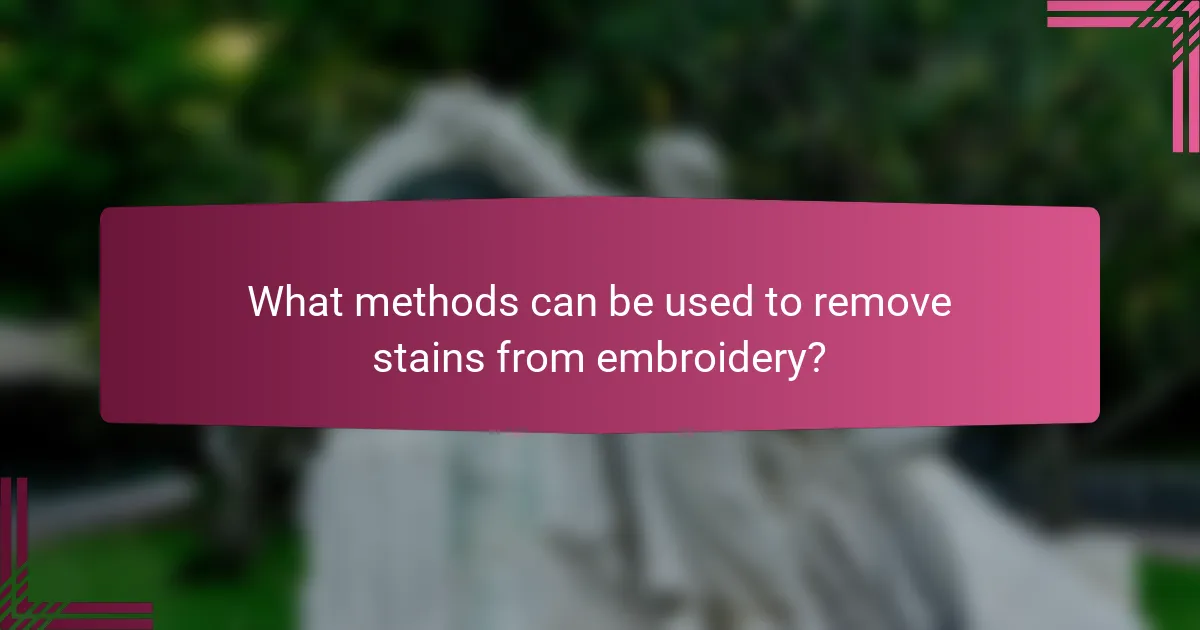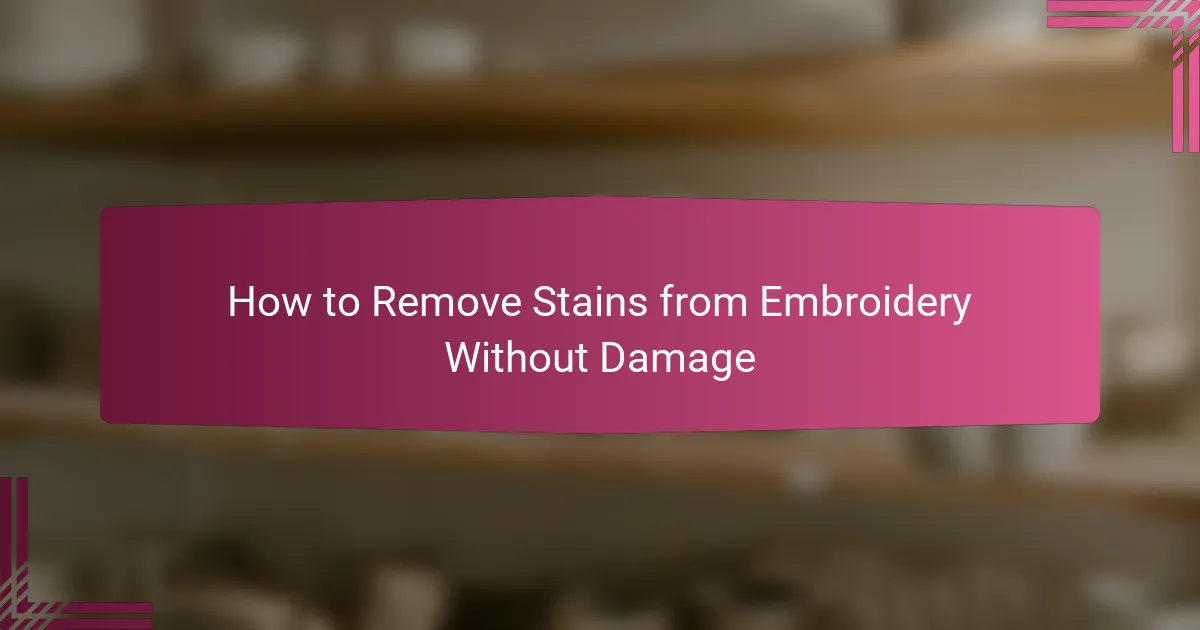
What are the common types of stains on embroidery?
Common types of stains on embroidery include grease, ink, food, and sweat. Grease stains often originate from cooking or handling oily substances. Ink stains can occur from pens or markers. Food stains typically result from spills during meals. Sweat stains are caused by perspiration, especially in warm conditions. Each type of stain has specific removal techniques to prevent damage to the embroidery. Proper identification of the stain type is crucial for effective treatment.
How do different stains affect embroidery?
Different stains can significantly affect embroidery by altering the fabric and thread appearance. For example, oil-based stains can cause the threads to become discolored and greasy. Water-based stains may lead to fading or bleeding of colors in the embroidery. Additionally, protein stains, like blood or sweat, can result in permanent discoloration if not treated promptly. Each type of stain interacts differently with the embroidery materials, impacting their longevity and aesthetic. Proper cleaning methods are essential to prevent damage and maintain the integrity of the embroidery.
What are the characteristics of water-based stains?
Water-based stains are characterized by their water-soluble nature. They easily dissolve in water, allowing for simpler cleanup. These stains typically have low levels of volatile organic compounds (VOCs). This makes them safer for indoor use compared to solvent-based stains. Water-based stains dry quickly, usually within one to two hours. They often have a less intense odor than oil-based alternatives. Additionally, they can provide a range of finishes, from matte to glossy. Water-based stains are versatile and can be used on various surfaces, including wood and fabric.
How do oil-based stains differ from other types?
Oil-based stains differ from other types primarily in their composition and removal methods. They are made from oils, which can penetrate fabrics more deeply than water-based stains. This [censured] makes oil-based stains more challenging to remove. Water-based stains typically sit on the surface and can be treated with water or mild detergents. In contrast, oil-based stains require solvents like rubbing alcohol or commercial stain removers to dissolve the oil. Additionally, oil-based stains can leave a residue that may require multiple cleaning attempts. This complexity highlights the need for specific techniques when addressing oil-based stains on delicate materials like embroidery.
Why is it important to treat stains promptly?
Promptly treating stains is crucial to prevent permanent damage to fabrics. Stains can set quickly, making them harder to remove later. For example, protein-based stains like blood or dairy can become permanent if not addressed within a few hours. Similarly, acidic stains, such as those from fruit, can cause discoloration over time. Immediate treatment often requires less aggressive cleaning methods, preserving the integrity of the fabric. Additionally, quick action can minimize the risk of odors developing from the stain. Therefore, addressing stains promptly is essential for maintaining the quality and appearance of embroidered items.
What are the potential consequences of untreated stains?
Untreated stains can lead to permanent discoloration of fabrics. Over time, stains can set into the material, making them increasingly difficult to remove. Bacteria and mold may develop in organic stains, posing health risks. Additionally, untreated stains can weaken the fabric fibers, resulting in damage and deterioration. This can lead to holes or tears in the material. The aesthetic appeal of the fabric decreases, impacting its overall value. In some cases, untreated stains may also attract more dirt and grime, compounding the problem.
How does time impact stain removal effectiveness?
Time significantly impacts stain removal effectiveness. Longer exposure to stain removal agents generally increases their effectiveness. This is because the chemicals in the agents have more time to penetrate and break down the stain. For example, allowing a stain remover to sit for at least 5 to 10 minutes can enhance its ability to lift stubborn stains. Conversely, if the removal process is rushed, stains may not fully dissolve, leading to incomplete removal. Studies show that many stain removal products recommend specific dwell times to maximize results. Thus, time is a crucial factor in achieving optimal stain removal outcomes.

What methods can be used to remove stains from embroidery?
To remove stains from embroidery, several effective methods can be utilized. First, cold water rinsing can help lift fresh stains. For oil-based stains, applying dish soap directly can break down the grease. A mixture of vinegar and water can effectively treat food stains. For ink stains, rubbing alcohol may be applied carefully. Stains from sweat can often be removed using a solution of baking soda and water. Always test any cleaning method on a small area first to ensure it does not damage the fabric. Using these methods can preserve the quality of the embroidery while effectively removing stains.
How do natural stain removal techniques work?
Natural stain removal techniques work by utilizing the properties of natural substances to break down and lift stains. Common ingredients include vinegar, baking soda, and lemon juice. These substances have acidic or alkaline properties that can dissolve various types of stains. For example, vinegar can effectively remove mineral deposits and odors. Baking soda acts as a gentle abrasive and neutralizes odors. Lemon juice has natural bleaching properties that can lighten stains. The effectiveness of these techniques is supported by their ability to target specific stain types, making them a safe alternative for delicate fabrics like embroidery.
What household items can be used for stain removal?
Household items that can be used for stain removal include white vinegar, baking soda, and dish soap. White vinegar is effective for breaking down stains and odors. Baking soda acts as a gentle abrasive and deodorizer. Dish soap can cut through grease and food stains. Hydrogen peroxide is useful for whitening and removing tough stains. Lemon juice has natural bleaching properties that can lighten stains. Rubbing alcohol can help with ink and dye stains. Salt can absorb moisture and lift stains from fabrics. Each of these items is commonly found in households and can be used safely on various fabrics.
How do these natural methods compare to commercial products?
Natural methods for removing stains from embroidery often offer gentler solutions compared to commercial products. They typically use non-toxic ingredients like vinegar, baking soda, and lemon juice. These ingredients can effectively lift stains without risking damage to delicate fabrics. In contrast, commercial products may contain harsh chemicals that can weaken fibers or alter colors. Studies show that natural methods can be just as effective for certain types of stains, such as food or dirt. Additionally, natural methods are often more environmentally friendly. This makes them a safer choice for both the fabric and the user.
What are the best practices for using commercial stain removers?
The best practices for using commercial stain removers include testing the product on a hidden area first. This ensures that the fabric will not be damaged or discolored. Apply the stain remover directly to the stain and let it sit for the recommended time. Follow the instructions provided on the product label for optimal results. Blot the stain gently with a clean cloth or sponge. Avoid rubbing, as it can spread the stain or damage the fabric. Rinse the treated area with cold water after the stain is removed. Finally, launder the item as usual, checking that the stain is completely gone before drying.
How can you choose the right product for your embroidery type?
To choose the right product for your embroidery type, identify the fabric and thread materials used. Different embroidery types require specific cleaning agents. For delicate fabrics like silk, use a mild detergent. For sturdier fabrics like cotton, a stronger solution may be appropriate. Always check the product label for compatibility with embroidery materials. Products formulated for delicate textiles help prevent damage. Additionally, consider the type of stain when selecting a product. Oily stains may need degreasing agents, while water-based stains require different treatments. Testing the product on a small, inconspicuous area is essential to ensure no adverse reactions occur.
What precautions should you take when using these products?
When using products to remove stains from embroidery, take care to test them first on a small, inconspicuous area. This helps ensure the product does not damage the fabric or alter colors. Use gentle cleaning solutions specifically designed for delicate fabrics. Avoid harsh chemicals that can weaken fibers. Apply the product lightly to prevent oversaturation. Blot stains instead of rubbing to minimize fabric distortion. Always follow the manufacturer’s instructions for the product used. Rinse thoroughly to remove any residue that could cause discoloration. Allow the embroidery to air dry completely before further handling.

How can you ensure that embroidery is not damaged during stain removal?
To ensure that embroidery is not damaged during stain removal, use gentle cleaning methods. Start by testing any cleaning solution on a hidden area first. This helps to check for colorfastness and fabric compatibility. Apply the cleaning solution with a soft cloth or sponge, avoiding direct application on the embroidery. Blot the stain gently instead of rubbing it, which can fray the threads. Rinse the area with cool water to remove any cleaning solution residue. Lay the embroidered item flat to dry, preventing distortion. Avoid using heat sources like dryers, as they can damage the embroidery. Following these steps minimizes the risk of damage during stain removal.
What techniques help protect the fabric while removing stains?
To protect fabric while removing stains, use gentle blotting techniques. Blotting prevents spreading the stain and minimizes damage. Use a clean cloth or paper towel to absorb the stain. Always start from the outer edges and work inward. This approach limits the area affected by the stain.
Additionally, test any cleaning solution on a hidden area first. This ensures the solution does not alter the fabric’s color or texture. Avoid harsh scrubbing, as it can weaken fibers. Instead, use soft brushes or sponges for application.
Using cold water is advisable, as hot water can set certain stains. Apply cleaning agents sparingly to prevent oversaturation. Rinsing the area thoroughly after treatment is essential to remove any residue. These techniques collectively help maintain the integrity of the fabric during stain removal.
How can you test for colorfastness before treatment?
To test for colorfastness before treatment, use a cotton swab or a white cloth. Dampen the swab or cloth with water. Rub it on a small, inconspicuous area of the fabric. Check for any color transfer onto the swab or cloth. If color transfers, the fabric is not colorfast. This method helps prevent damage during stain removal. It is a reliable test used by professionals in fabric care.
What tools can assist in safe stain removal?
Safe stain removal can be assisted by several tools. Common tools include soft-bristle brushes, microfiber cloths, and cotton swabs. Soft-bristle brushes gently lift stains without damaging fabric. Microfiber cloths absorb moisture and prevent spreading stains. Cotton swabs allow for precise application of cleaning solutions. Additionally, stain removal kits specifically designed for delicate fabrics are beneficial. These kits often include pH-balanced cleaners and instructions tailored for safe use. Using these tools helps maintain the integrity of embroidered items while effectively removing stains.
What steps should you follow for effective stain removal?
To effectively remove stains from embroidery, follow these steps. First, identify the type of stain. Different stains require different treatments. Next, gently blot the stain with a clean cloth to absorb excess liquid. Avoid rubbing, as this can damage the embroidery. Then, prepare a cleaning solution suitable for the fabric. Use mild detergent mixed with water for most stains. Apply the solution to the stained area using a soft brush or cloth. Rinse the area with cold water to remove the cleaning solution. Finally, air dry the embroidery away from direct sunlight to prevent fading. These steps ensure that the embroidery remains intact while effectively removing stains.
How do you prepare the stained embroidery for treatment?
To prepare stained embroidery for treatment, first, gently shake off any loose dirt or debris. Next, lay the embroidery flat on a clean, dry surface. Use a soft brush to carefully remove any remaining particles. Then, identify the type of stain present, as this will influence the treatment method. For fabric stains, test a small, inconspicuous area with water to check for colorfastness. If the colors do not bleed, proceed to dampen the stained area with cool water. Avoid soaking the fabric, as excessive moisture can cause damage. Finally, use a mild detergent on the stain, applying it gently with a soft cloth or sponge.
What is the recommended process for applying stain removal agents?
The recommended process for applying stain removal agents involves several key steps. First, identify the type of stain and the fabric of the embroidery. Next, test the stain removal agent on a hidden area to check for colorfastness. After confirming safety, apply the agent directly to the stained area using a clean cloth or sponge. Gently blot the stain, avoiding rubbing, which can damage the fabric. Allow the agent to sit for the recommended time, usually 5 to 10 minutes, to break down the stain. Rinse the area thoroughly with cold water to remove the agent and loosened stain. Finally, air dry the embroidery away from direct sunlight. These steps ensure effective stain removal while preserving the integrity of the embroidery.
What are some common troubleshooting tips for stain removal?
Common troubleshooting tips for stain removal include acting quickly to treat stains. Blot the stain gently with a clean cloth to absorb excess liquid. Avoid rubbing, as it may spread the stain. Test any cleaning solution on a hidden area first. Use cold water for protein-based stains and warm water for oily stains. Apply a stain remover directly to the affected area and let it sit for the recommended time. Rinse thoroughly after treatment. For stubborn stains, repeat the process or consult a professional cleaner.
How can you handle stubborn stains that resist removal?
To handle stubborn stains that resist removal, start by identifying the type of stain. Different stains require specific treatments. For example, grease stains may need a degreaser while ink stains might require alcohol. Apply the appropriate cleaning solution directly to the stain. Allow it to sit for a few minutes to penetrate the fabric. Gently blot the stain with a clean cloth to lift the stain. Rinse the area with cold water to remove any residue. Repeat the process if necessary until the stain is gone. Always test any cleaning solution on a small, inconspicuous area first to avoid damage.
What should you do if the fabric shows signs of damage after treatment?
If the fabric shows signs of damage after treatment, stop using the cleaning method immediately. Assess the extent of the damage to determine the next steps. If possible, gently clean the area with cold water to remove any remaining cleaning solution. Allow the fabric to air dry completely to evaluate the damage better. If the damage persists, consider consulting a professional cleaner for advice. In some cases, fabric repair techniques may be necessary. Always test cleaning methods on a small, inconspicuous area first to prevent damage. Regular maintenance can help preserve the fabric’s integrity over time.
The main entity of this article is “embroidery” with a focus on the removal of stains without causing damage. The article outlines common types of stains such as grease, ink, food, and sweat, and explains how each affects embroidery. It provides effective techniques for stain removal, emphasizing the importance of prompt treatment and the use of appropriate cleaning agents, including natural and commercial products. Additionally, it covers best practices for protecting the fabric during the cleaning process and troubleshooting tips for stubborn stains, ensuring the preservation of the embroidery’s quality and appearance.
